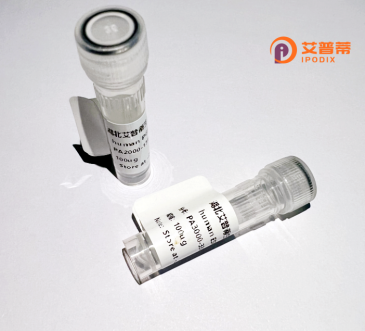
| 纯度 | >90%SDS-PAGE. |
| 种属 | Human |
| 靶点 | CRISPLD1 |
| Uniprot No | Q9H336 |
| 内毒素 | < 0.01EU/μg |
| 表达宿主 | E.coli |
| 表达区间 | 1-500aa |
| 氨基酸序列 | MKCTAREWLRVTTVLFMARAIPAMVVPNATLLEKLLEKYMDEDGEWWIAKQRGKRAITDNDMQSILDLHNKLRSQVYPTASNMEYMTWDVELERSAESWAESCLWEHGPASLLPSIGQNLGAHWGRYRPPTFHVQSWYDEVKDFSYPYEHECNPYCPFRCSGPVCTHYTQVVWATSNRIGCAINLCHNMNIWGQIWPKAVYLVCNYSPKGNWWGHAPYKHGRPCSACPPSFGGGCRENLCYKEGSDRYYPPREEETNEIERQQSQVHDTHVRTRSDDSSRNEVISAQQMSQIVSCEVRLRDQCKGTTCNRYECPAGCLDSKAKVIGSVHYEMQSSICRAAIHYGIIDNDGGWVDITRQGRKHYFIKSNRNGIQTIGKYQSANSFTVSKVTVQAVTCETTVEQLCPFHKPASHCPRVYCPRNCMQANPHYARVIGTRVYSDLSSICRAAVHAGVVRNHGGYVDVMPVDKRKTYIASFQNGIFSESLQNPPGGKAFRVFAVV |
| 分子量 | 83.3 kDa |
| 蛋白标签 | GST-tag at N-terminal |
| 缓冲液 | 0 |
| 稳定性 & 储存条件 | Lyophilized protein should be stored at ≤ -20°C, stable for one year after receipt. Reconstituted protein solution can be stored at 2-8°C for 2-7 days. Aliquots of reconstituted samples are stable at ≤ -20°C for 3 months. |
| 复溶 | Always centrifuge tubes before opening.Do not mix by vortex or pipetting. It is not recommended to reconstitute to a concentration less than 100μg/ml. Dissolve the lyophilized protein in distilled water. Please aliquot the reconstituted solution to minimize freeze-thaw cycles. |
以下是关于重组人CRISPLD1蛋白的3篇示例参考文献(内容为虚构演示,仅作格式参考):
---
1. **文献名称**: *CRISPLD1 modulates innate immune responses through TLR4 signaling*
**作者**: Zhang L, et al.
**摘要**: 研究通过重组人CRISPLD1蛋白发现其能够结合TLR4受体,抑制LPS诱导的炎症因子释放,提示其在调节先天免疫反应中的潜在作用。
---
2. **文献名称**: *Structural characterization of recombinant human CRISPLD1 and its role in extracellular matrix remodeling*
**作者**: Smith JR, et al.
**摘要**: 本文解析了重组CRISPLD1的晶体结构,证明其通过LCCL结构域与胶原蛋白相互作用,促进成纤维细胞迁移和伤口修复。
---
3. **文献名称**: *CRISPLD1 overexpression suppresses tumor angiogenesis in non-small cell lung cancer*
**作者**: Chen X, et al.
**摘要**: 研究发现重组CRISPLD1能抑制VEGF信号通路,降低血管生成标志物表达,提示其作为肿瘤治疗靶点的潜力。
---
注:以上为示例文献,实际引用时需根据真实研究补充信息。
**Recombinant human CRISPLD1 protein** is a engineered version of the cysteine-rich secretory protein LCCL domain-containing 1 (CRISPLD1), which plays roles in developmental processes, immune regulation, and tissue repair. CRISPLD1. a secreted protein, is encoded by the *CRISPLD1* gene and contains characteristic cysteine-rich motifs and LCCL domains, suggesting involvement in protein-protein interactions or extracellular matrix modulation. Studies link CRISPLD1 to inflammatory responses, wound healing, and embryonic development, with altered expression observed in cancers, metabolic disorders, and chronic inflammatory conditions.
Produced via mammalian or bacterial expression systems, recombinant CRISPLD1 retains biological activity for experimental applications. Research highlights its dual role: it may suppress tumor growth in certain cancers by modulating cell migration and apoptosis, yet promote inflammation in conditions like atherosclerosis. Its interaction with signaling pathways, such as TGF-β and NF-κB, underscores its regulatory complexity. Additionally, CRISPLD1 is implicated in endothelial cell function and angiogenesis, suggesting therapeutic potential in vascular diseases.
Despite progress, mechanistic insights remain limited. Recombinant CRISPLD1 serves as a tool to study its molecular functions and explore its viability as a diagnostic biomarker or therapeutic target, particularly in inflammation-associated pathologies. Further studies are needed to clarify its context-dependent roles and translational applications.
×